Difference between revisions of "Interfacing GLCD(128x64) with PIC16F877A"
(→Downloads) |
|||
| (23 intermediate revisions by the same user not shown) | |||
| Line 1: | Line 1: | ||
[[Category:PIC Tutorials]] | [[Category:PIC Tutorials]] | ||
| + | [[Category:GLCD KS108]] | ||
In this tutorial we will see how to interface and graphical LCD(GLCD) with PIC16F877A. In this tutorial we will look at interfacing KS0108 controller based JHD12864E display. There are many displays out there based on KS0108 or compatible display controller. They all work the same way, but make sure to check the datasheet for the pin diagram before doing the connection. | In this tutorial we will see how to interface and graphical LCD(GLCD) with PIC16F877A. In this tutorial we will look at interfacing KS0108 controller based JHD12864E display. There are many displays out there based on KS0108 or compatible display controller. They all work the same way, but make sure to check the datasheet for the pin diagram before doing the connection. | ||
| Line 57: | Line 58: | ||
<br> | <br> | ||
| − | =Page | + | =Page, Line and Cursor Selection= |
[[FILE:GLCD Pages.png]] | [[FILE:GLCD Pages.png]] | ||
Lets view the GLCD as a open book with 2pages constisting of 8lines on each page.<br> | Lets view the GLCD as a open book with 2pages constisting of 8lines on each page.<br> | ||
| − | The required page can be selected using CS1,CS2 pins as shown below. | + | Each line has 64 cursors positions to display data/images.<br> |
| + | The required page can be selected using CS1,CS2 pins as shown below.<br> | ||
<b>CS2-CS1:</b>Chip Select Lines<br> | <b>CS2-CS1:</b>Chip Select Lines<br> | ||
| − | 00 = | + | 00 = None<br> |
01 = Page 0<br> | 01 = Page 0<br> | ||
10 = Page 1<br> | 10 = Page 1<br> | ||
| − | 11 = | + | 11 = Both Pages |
==Line Selection== | ==Line Selection== | ||
| Line 74: | Line 76: | ||
|7 || 6 || 5 || 4 || 3 || 2 || 1 || 0 | |7 || 6 || 5 || 4 || 3 || 2 || 1 || 0 | ||
|- | |- | ||
| − | |1|| 0 || 1 || 1 || 1 || | + | |1|| 0 || 1 || 1 || 1 || Y2 || Y1 || Y0 |
|} | |} | ||
<b>Y2-Y0:</b>Line Selection<br> | <b>Y2-Y0:</b>Line Selection<br> | ||
| Line 86: | Line 88: | ||
111 = Line7 (Address = 0xBF) | 111 = Line7 (Address = 0xBF) | ||
| − | + | ===Cursor/Char Position=== | |
| − | ==Cursor/Char Position== | + | |
To set the cursor position(0-63) we need to send its address to GLCD.<br> | To set the cursor position(0-63) we need to send its address to GLCD.<br> | ||
The cursor positions address starts from 0x40 and goes till 0x7f as shown below. | The cursor positions address starts from 0x40 and goes till 0x7f as shown below. | ||
| Line 99: | Line 100: | ||
000000 = Cursor Position 0 (Address = 0x40)<br> | 000000 = Cursor Position 0 (Address = 0x40)<br> | ||
000001 = Cursor Position 1 (Address = 0x41)<br> | 000001 = Cursor Position 1 (Address = 0x41)<br> | ||
| − | + | 000010 = Cursor Position 2 (Address = 0x42)<br> | |
| − | ' | + | '<br> |
| − | + | ||
111111 = Cursor Position 63 (Address = 0x7F) | 111111 = Cursor Position 63 (Address = 0x7F) | ||
| + | |||
| + | ===Instruction Set=== | ||
| + | Below is the complete instruction table. | ||
| + | [[FILE:GLCD InstructionSet.png]] | ||
| + | |||
| + | =Steps= | ||
| + | |||
| + | ===Steps for Sending Command:=== | ||
| + | *step1: Send the I/P command to LCD. | ||
| + | *step2: Select the Control Register by making RS low. | ||
| + | *step3: Select Write operation making RW low. | ||
| + | *step4: Send a High-to-Low pulse on Enable PIN with some delay_us. | ||
| + | <html> | ||
| + | <script src="https://gist.github.com/SaheblalBagwan/f56a8cb536a46213f4132455f0190e2d.js"></script> | ||
| + | </html> | ||
| + | <br> | ||
| + | |||
| + | ===Steps for Sending Data:=== | ||
| + | *step1: Send the character to LCD. | ||
| + | *step2: Select the Data Register by making RS high. | ||
| + | *step3: Select Write operation making RW low. | ||
| + | *step4: Send a High-to-Low pulse on Enable PIN with some delay. | ||
| + | <html> | ||
| + | <script src="https://gist.github.com/SaheblalBagwan/466f8bd7feae27e51f9593e34379070b.js"></script> | ||
| + | </html> | ||
| + | <br> | ||
| + | |||
| + | |||
| + | =Code= | ||
| + | Below is the sample code for displaying HELLO WORLD on two different pages of GLCD. | ||
| + | <html> | ||
| + | <script src="https://gist.github.com/SaheblalBagwan/9a50df223dc284c41074345369636d42.js"></script> | ||
| + | </html> | ||
| + | |||
| + | =Using ExploreEmbedded GLCD Lib= | ||
| + | <html> | ||
| + | <script src="https://gist.github.com/SaheblalBagwan/18af0f168e1263ce5bcf0110e296ef12.js"></script> | ||
| + | </html> | ||
| + | [[FILE:0Glcd iterfacing with PIC16f877a.png]] | ||
| + | |||
| + | =Displaying Numbers= | ||
| + | <html> | ||
| + | <script src="https://gist.github.com/SaheblalBagwan/17b64c4e262e9173b3823d12d1eced4a.js"></script> | ||
| + | </html> | ||
| + | [[FILE:Glcd DisplayNumber.png]] | ||
| + | <br><br> | ||
| + | |||
| + | =Displaying Bar Graphs= | ||
| + | |||
| + | <html> | ||
| + | <script src="https://gist.github.com/SaheblalBagwan/49e0ad0b4d5617535430989c6736d8af.js"></script> | ||
| + | </html> | ||
| + | [[FILE:Glcd HorizontalGraph.png]] | ||
| + | <br><br> | ||
| + | |||
| + | |||
| + | <html> | ||
| + | <script src="https://gist.github.com/SaheblalBagwan/28b1f36fc769b7ab785c414672380eff.js"></script> | ||
| + | </html> | ||
| + | [[FILE:Glcd VerticalGraph.png]] | ||
| + | <br><br> | ||
| + | |||
| + | =Downloads= | ||
| + | Download the complete project folder from the below link:<br> | ||
| + | [https://github.com/ExploreEmbedded/Pic16f877a_ExploreUltraPicDevKit Hardware design Files and Code Library] | ||
| + | |||
| + | |||
| + | Have a opinion, suggestion , question or feedback about the article let it out here! | ||
| + | {{DISQUS}} | ||
Latest revision as of 13:00, 23 September 2017
In this tutorial we will see how to interface and graphical LCD(GLCD) with PIC16F877A. In this tutorial we will look at interfacing KS0108 controller based JHD12864E display. There are many displays out there based on KS0108 or compatible display controller. They all work the same way, but make sure to check the datasheet for the pin diagram before doing the connection.
We will look at the working of the display, the hardware setup and programming with PIC16F877A. You may use any other AVR,8051,PIC,ARM controller as well. We have it tested and working on 8051, AVR, PIC and ARM. We have similar tutorials on these MCUs as well.
Unlike a 16 x 2 display, this does not have a character map for ascii values stored on its ROM. However it allows us the flexibility of creating fonts like Arial, times new roman etc. We could also display bit-map images on it and stretching it little further we can make GUI's and little animation, but that's for another day. So lets get started.
Contents
[hide]GLCD Internals And Pinout
Below image shows the internal block diagram of 128x64 GLCD along with its pin out.
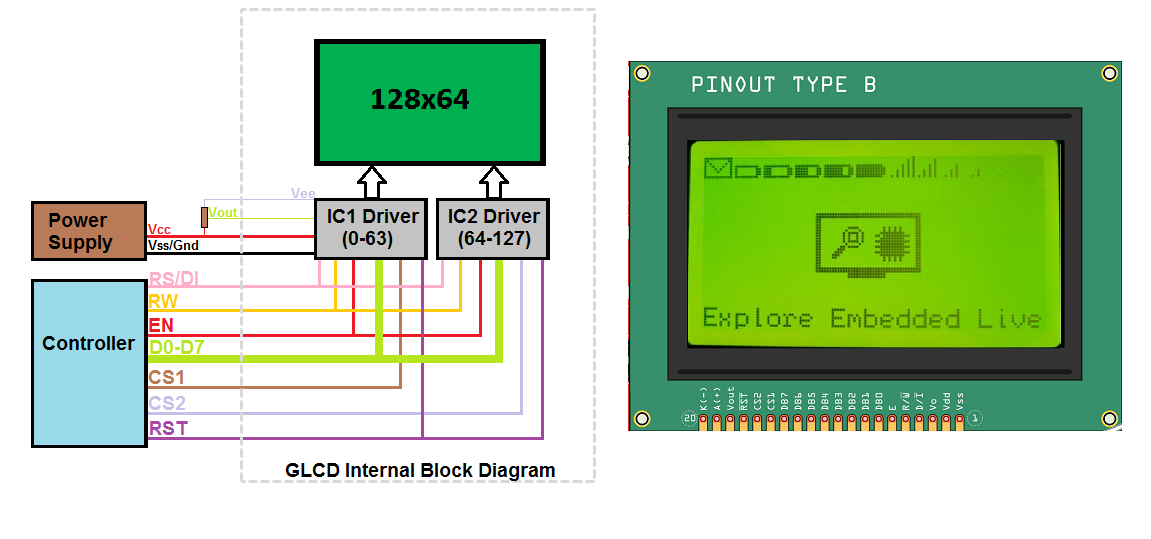 As per the name it has 128pixels on X-axis and 64-pixels on Y-axis. Further the X-axis is divided into two parts of 64 pixels each and controlled by unique contoller/driver IC as shown in the above image.
Below table provides the detailed info of all the GLCD pins.
As per the name it has 128pixels on X-axis and 64-pixels on Y-axis. Further the X-axis is divided into two parts of 64 pixels each and controlled by unique contoller/driver IC as shown in the above image.
Below table provides the detailed info of all the GLCD pins.
| Pin Number | Symbol | Pin Function |
| 1 | VSS | Ground |
| 2 | VCC | +5v |
| 3 | VO | Contrast adjustment (VO) |
| 4 | RS/DI | Register Select/Data Instruction. 0:Instruction, 1: Data |
| 5 | R/W | Read/Write, R/W=0: Write & R/W=1: Read |
| 6 | EN | Enable. Falling edge triggered |
| 7 | D0 | Data Bit 0 |
| 8 | D1 | Data Bit 1 |
| 9 | D2 | Data Bit 2 |
| 10 | D3 | Data Bit 3 |
| 11 | D4 | Data Bit 4 |
| 12 | D5 | Data Bit 5 |
| 13 | D6 | Data Bit 6 |
| 14 | D7 | Data Bit 7/Busy Flag |
| 15 | CS1 | Chip Select for IC1/PAGE0 |
| 16 | CS2 | Chip Select for IC2/PAGE1 |
| 17 | RST | Reset the LCD module |
| 18 | VEE | Negative voltage used along with Vcc for brightness control |
| 15 | A/LED+ | Back-light Anode(+) |
| 16 | K/LED- | Back-Light Cathode(-) |
Page, Line and Cursor Selection
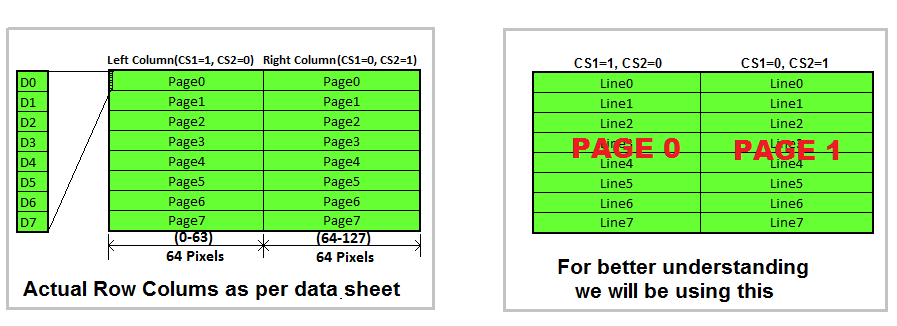 Lets view the GLCD as a open book with 2pages constisting of 8lines on each page.
Lets view the GLCD as a open book with 2pages constisting of 8lines on each page.
Each line has 64 cursors positions to display data/images.
The required page can be selected using CS1,CS2 pins as shown below.
CS2-CS1:Chip Select Lines
00 = None
01 = Page 0
10 = Page 1
11 = Both Pages
Line Selection
To select the lines we need to send the command/line address to GLCD.
The line address starts from 0xb8 and goes till 0xbf as shown below.
| 7 | 6 | 5 | 4 | 3 | 2 | 1 | 0 |
| 1 | 0 | 1 | 1 | 1 | Y2 | Y1 | Y0 |
Y2-Y0:Line Selection
000 = Line0 (Address = 0xB8)
001 = Line1 (Address = 0xB9)
010 = Line2 (Address = 0xBA)
011 = Line3 (Address = 0xBB)
100 = Line4 (Address = 0xBC)
101 = Line5 (Address = 0xBD)
110 = Line6 (Address = 0xBE)
111 = Line7 (Address = 0xBF)
Cursor/Char Position
To set the cursor position(0-63) we need to send its address to GLCD.
The cursor positions address starts from 0x40 and goes till 0x7f as shown below.
| 7 | 6 | 5 | 4 | 3 | 2 | 1 | 0 |
| 0 | 1 | x5 | x4 | x3 | x2 | x1 | x0 |
x5-x0:Line Selection
000000 = Cursor Position 0 (Address = 0x40)
000001 = Cursor Position 1 (Address = 0x41)
000010 = Cursor Position 2 (Address = 0x42)
'
111111 = Cursor Position 63 (Address = 0x7F)
Instruction Set
Below is the complete instruction table.
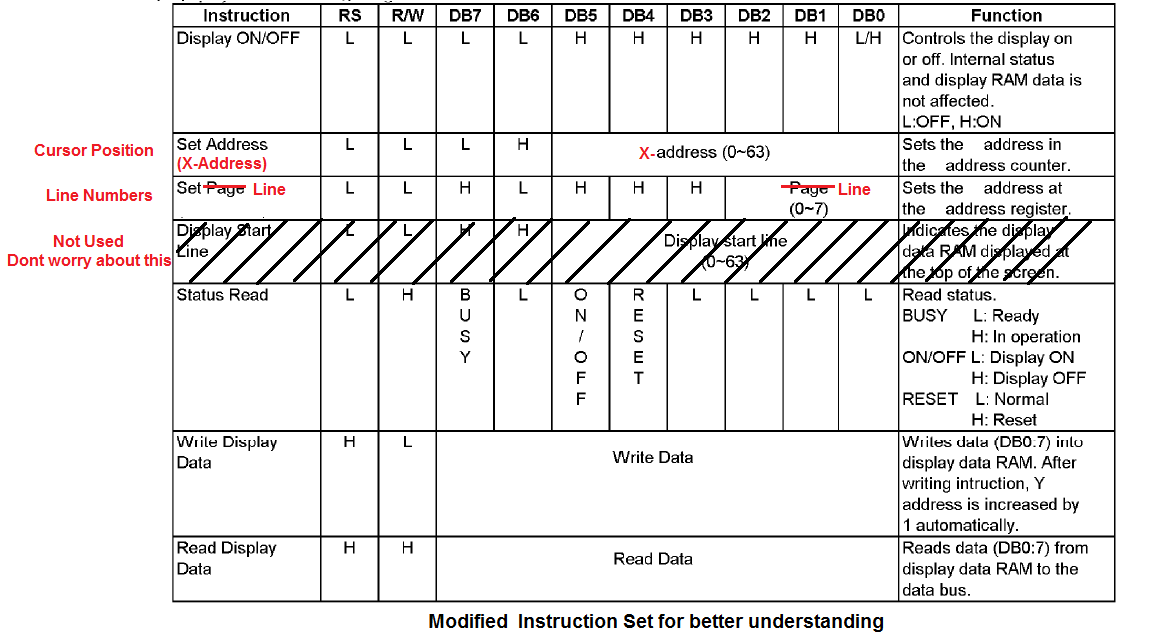
Steps
Steps for Sending Command:
- step1: Send the I/P command to LCD.
- step2: Select the Control Register by making RS low.
- step3: Select Write operation making RW low.
- step4: Send a High-to-Low pulse on Enable PIN with some delay_us.
| /* Function to send the command to LCD */ | |
| void Glcd_CmdWrite(char cmd) | |
| { | |
| GlcdDataBus = cmd; //Send the Command nibble | |
| GlcdControlBus &= ~(1<<RS); // Send LOW pulse on RS pin for selecting Command register | |
| GlcdControlBus &= ~(1<<RW); // Send LOW pulse on RW pin for Write operation | |
| GlcdControlBus |= (1<<EN); // Generate a High-to-low pulse on EN pin | |
| delay(100); | |
| GlcdControlBus &= ~(1<<EN); | |
| delay(1000); | |
| } |
Steps for Sending Data:
- step1: Send the character to LCD.
- step2: Select the Data Register by making RS high.
- step3: Select Write operation making RW low.
- step4: Send a High-to-Low pulse on Enable PIN with some delay.
| /* Function to send the Data to LCD */ | |
| void Glcd_DataWrite(char dat) | |
| { | |
| GlcdDataBus = dat; //Send the data on DataBus nibble | |
| GlcdControlBus |= (1<<RS); // Send HIGH pulse on RS pin for selecting data register | |
| GlcdControlBus &= ~(1<<RW); // Send LOW pulse on RW pin for Write operation | |
| GlcdControlBus |= (1<<EN); // Generate a High-to-low pulse on EN pin | |
| delay(100); | |
| GlcdControlBus &= ~(1<<EN); | |
| delay(1000); | |
| } |
Code
Below is the sample code for displaying HELLO WORLD on two different pages of GLCD.
| #include<pic16f877a.h> | |
| /* Configure the data bus and Control bus as per the hardware connection | |
| Dtatus bus is connected to PB0:PB7 and control bus PD0:PD4*/ | |
| #define GlcdDataBus PORTB | |
| #define GlcdControlBus PORTD | |
| #define GlcdDataBusDirnReg TRISB | |
| #define GlcdCtrlBusDirnReg TRISD | |
| #define RS 0 | |
| #define RW 1 | |
| #define EN 2 | |
| #define CS1 3 | |
| #define CS2 4 | |
| /* 5x7 Font including 1 space to display HELLO WORLD */ | |
| char H[]={0x7F, 0x08, 0x08, 0x08, 0x7F, 0x00}; | |
| char E[]={0x7F, 0x49, 0x49, 0x49, 0x41, 0x00}; | |
| char L[]={0x7F, 0x40, 0x40, 0x40, 0x40, 0x00}; | |
| char O[]={0x3E, 0x41, 0x41, 0x41, 0x3E, 0x00}; | |
| char W[]={0x3F, 0x40, 0x38, 0x40, 0x3F, 0x00}; | |
| char R[]={0x7F, 0x09, 0x19, 0x29, 0x46, 0x00}; | |
| char D[]={0x7F, 0x41, 0x41, 0x22, 0x1C, 0x00}; | |
| /* local function to generate delay */ | |
| void delay(int cnt) | |
| { | |
| int i; | |
| for(i=0;i<cnt;i++); | |
| } | |
| void Glcd_SelectPage0() // CS1=1, CS2=0 | |
| { | |
| GlcdControlBus |= (1<<CS1); | |
| GlcdControlBus &= ~(1<<CS2); | |
| } | |
| void Glcd_SelectPage1() // CS1=0, CS1=1 | |
| { | |
| GlcdControlBus &= ~(1<<CS1); | |
| GlcdControlBus |= (1<<CS2); | |
| } | |
| /* Function to send the command to LCD */ | |
| void Glcd_CmdWrite(char cmd) | |
| { | |
| GlcdDataBus = cmd; //Send the Command nibble | |
| GlcdControlBus &= ~(1<<RS); // Send LOW pulse on RS pin for selecting Command register | |
| GlcdControlBus &= ~(1<<RW); // Send LOW pulse on RW pin for Write operation | |
| GlcdControlBus |= (1<<EN); // Generate a High-to-low pulse on EN pin | |
| delay(100); | |
| GlcdControlBus &= ~(1<<EN); | |
| delay(1000); | |
| } | |
| /* Function to send the Data to LCD */ | |
| void Glcd_DataWrite(char dat) | |
| { | |
| GlcdDataBus = dat; //Send the data on DataBus nibble | |
| GlcdControlBus |= (1<<RS); // Send HIGH pulse on RS pin for selecting data register | |
| GlcdControlBus &= ~(1<<RW); // Send LOW pulse on RW pin for Write operation | |
| GlcdControlBus |= (1<<EN); // Generate a High-to-low pulse on EN pin | |
| delay(100); | |
| GlcdControlBus &= ~(1<<EN); | |
| delay(1000); | |
| } | |
| void Glcd_DisplayChar(char *ptr_array) | |
| { | |
| int i; | |
| for(i=0;i<6;i++) // 5x7 font, 5 chars + 1 blankspace | |
| Glcd_DataWrite(ptr_array[i]); | |
| } | |
| int main() | |
| { | |
| GlcdDataBusDirnReg = 0x00; // Configure all the LCD pins as output | |
| GlcdCtrlBusDirnReg = 0x00; // Configure the Ctrl pins as output | |
| /* Select the Page0/Page1 and Turn on the GLCD */ | |
| Glcd_SelectPage0(); | |
| Glcd_CmdWrite(0x3f); | |
| Glcd_SelectPage1(); | |
| Glcd_CmdWrite(0x3f); | |
| delay(100); | |
| /* Select the Page0/Page1 and Enable the GLCD */ | |
| Glcd_SelectPage0(); | |
| Glcd_CmdWrite(0xc0); | |
| Glcd_SelectPage1(); | |
| Glcd_CmdWrite(0xc0); | |
| delay(100); | |
| Glcd_SelectPage0(); // Display HELLO on Page0, Line1 | |
| Glcd_CmdWrite(0xb8); | |
| Glcd_DisplayChar(H); | |
| Glcd_DisplayChar(E); | |
| Glcd_DisplayChar(L); | |
| Glcd_DisplayChar(L); | |
| Glcd_DisplayChar(O); | |
| Glcd_SelectPage1(); // Display WORLD on Page1, Last line | |
| Glcd_CmdWrite(0xbF); | |
| Glcd_DisplayChar(W); | |
| Glcd_DisplayChar(O); | |
| Glcd_DisplayChar(R); | |
| Glcd_DisplayChar(L); | |
| Glcd_DisplayChar(D); | |
| while(1); | |
| } |
Using ExploreEmbedded GLCD Lib
| #include "glcd.h" //User defined LCD library which contains the lcd routines | |
| #include "delay.h" | |
| /* start the main program */ | |
| void main() | |
| { | |
| /* Initialize the glcd before displaying any thing on the lcd */ | |
| GLCD_Init(); | |
| GLCD_Printf("Interfacing\n\n"); | |
| GLCD_Printf(" KS108 128x64\n\n"); | |
| GLCD_Printf(" With Pic16f877a"); | |
| GLCD_GoToLine(6); | |
| GLCD_Printf(" ExploreEmbedded"); | |
| while(1); | |
| } |
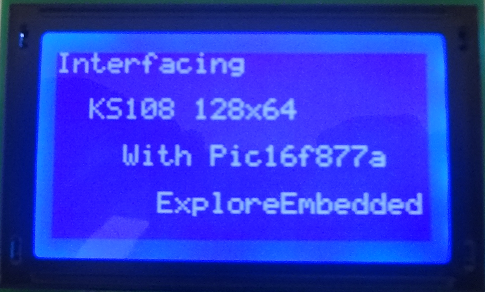
Displaying Numbers
| #include "glcd.h" | |
| #include "delay.h" | |
| void main() | |
| { | |
| int count=0; | |
| GLCD_Init(); | |
| GLCD_DisplayString(" Displaying Numbers"); | |
| while(1) | |
| { | |
| GLCD_GoToLine(2); | |
| GLCD_Printf("hex:%4x \n\ndec:%5d \n\nbin:%16b",count,count,count); | |
| DELAY_ms(100); | |
| count++; | |
| } | |
| } |
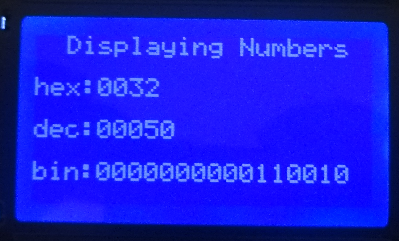
Displaying Bar Graphs
| #include "glcd.h" | |
| void main() | |
| { | |
| GLCD_Init(); | |
| GLCD_HorizontalGraph(0,45); | |
| GLCD_HorizontalGraph(1,50); | |
| GLCD_HorizontalGraph(2,82); | |
| GLCD_HorizontalGraph(3,74); | |
| while(1); | |
| } |
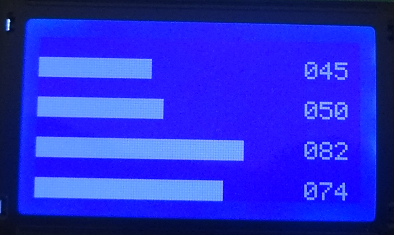
| #include "glcd.h" | |
| void main() | |
| { | |
| GLCD_Init(); | |
| GLCD_VerticalGraph(0,45); | |
| GLCD_VerticalGraph(1,50); | |
| GLCD_VerticalGraph(2,82); | |
| GLCD_VerticalGraph(3,74); | |
| while(1); | |
| } |
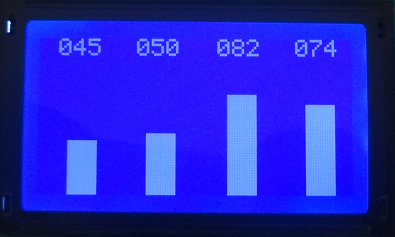
Downloads
Download the complete project folder from the below link:
Hardware design Files and Code Library
Have a opinion, suggestion , question or feedback about the article let it out here!
